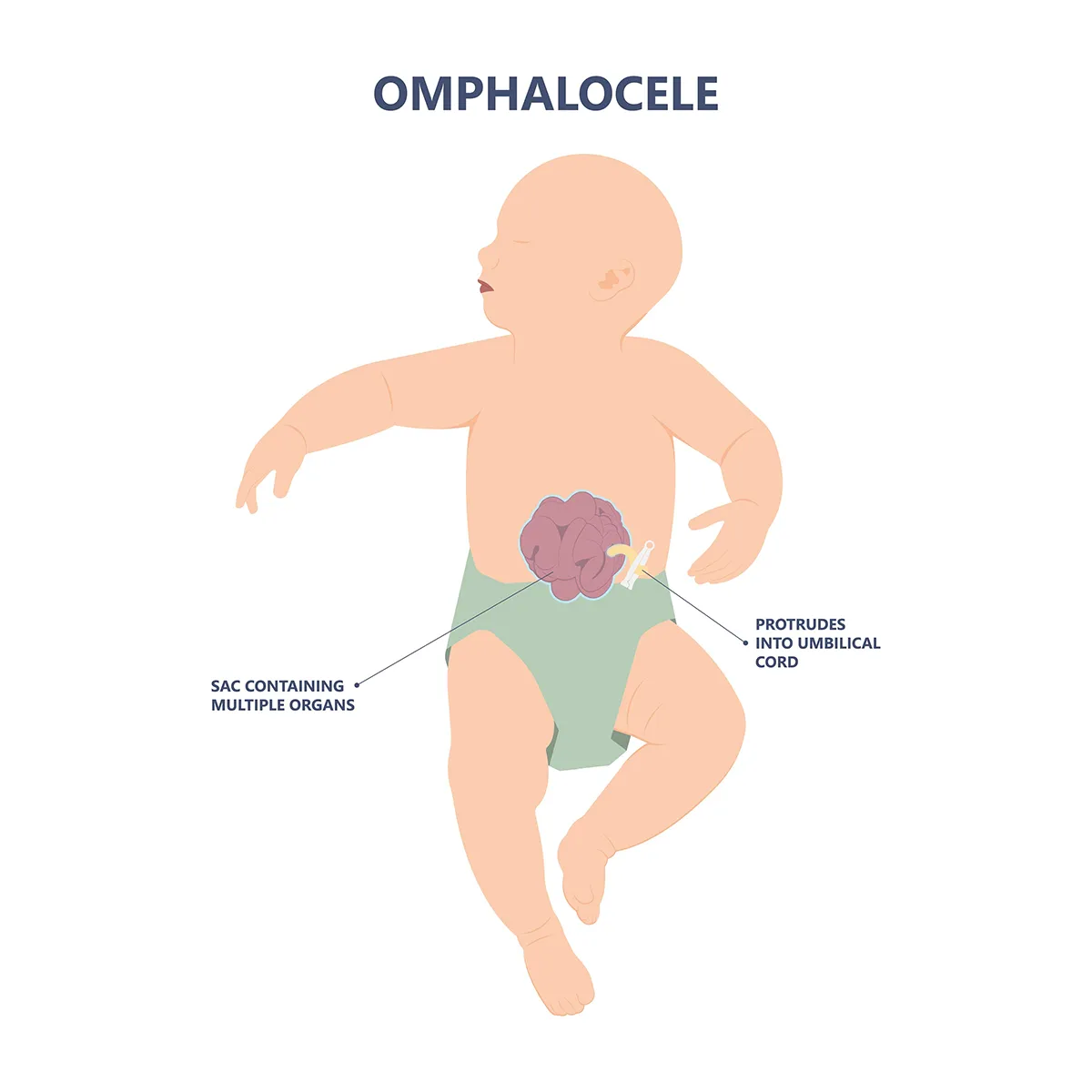Omphalocele
Find a fetal care specialistOmphalocele is a rare abdominal wall defect where a baby is born with some of their organs sticking out of the abdominal cavity (belly) through the base of the umbilical cord.
At Advocate Children’s Hospital, we have fetal care experts who assist in diagnosis during pregnancy and advise about treatment for an omphalocele once your baby is born.
About omphalocele

An omphalocele can involve part or all of the intestines, along with other organs such as the liver.
Having the intestines or other organs outside the belly is an expected step in the early development of the fetus. The organs are wrapped in a protective sac and protrude through the navel (belly button). Usually, these organs go back into the belly by the 11th week of pregnancy. When that doesn’t happen, a baby may be born with their organs still outside their body, a condition called omphalocele (also known as exomphalos).
Some omphaloceles are small and have only part of the intestines sticking out. Larger omphaloceles are called giant omphaloceles and include more of the intestines along with other organs such as the liver and spleen.
Omphalocele vs. gastroschisis
Both omphalocele and gastroschisis are birth anomalies (defects) that involve a problem with the abdominal wall. However, there are important differences.
With gastroschisis, the opening in the abdomen is next to the belly button, usually to the right. Also, there is no protective covering over the intestines or other organs that stick out from the belly, so the organs are more likely to be damaged or infected during pregnancy or birth.
If gastroschisis is discovered during an ultrasound, you will likely need to give birth through a cesarean section to minimize damage to the intestines or other organs.
With omphalocele, the intestines or other organs stick out through the baby’s belly button and are usually covered with a sac that protects them from infection and damage. You may need to give birth through a cesarean section, but you may be able to have a vaginal birth.
Risk factors for omphalocele
Environmental factors may make omphalocele more common, but more research is needed to better understand this.
Some confirmed risk factors for having a baby with an omphalocele are:
- Obesity, diabetes or high blood pressure before pregnancy
- Alcohol or heavy tobacco use before or during pregnancy
- Use of selective serotonin-reuptake inhibitor (SSRI) medications during pregnancy
- Pregnancy after the age of 35
Genetics may also be a factor as omphalocele sometimes runs in families . Omphalocele may also occur with trisomy 13 (Patau syndrome), trisomy 18 (Edwards’ syndrome) or trisomy 21 (Down syndrome).
Diagnosis of omphalocele
Omphalocele may be diagnosed through a prenatal ultrasound exam because it’s a highly visible condition. If it’s not recognized during pregnancy, it becomes obvious after your baby is born.
When omphalocele is diagnosed, your baby will also be examined for abnormalities of the spine, limbs, digestive system, heart or urinary system. About two-thirds of babies with omphalocele also have defects affecting these parts of their bodies.
Complications of omphalocele
Complications from having an omphalocele may be that the protective sac breaks open during or after birth. This can lead to more chances of infection or damage to your baby’s organs.
Organs may also become twisted or pinched because of their position and their blood supply may be blocked, leading to damage to the affected organs.
How common is omphalocele?
Omphalocele is rare and affects about one in every 4,200 babies born in the U.S.
How is an omphalocele treated?
Omphalocele treatment depends on the size of the defect and the health of the affected organs. Your baby will need to have their organs moved back into their belly. With a small omphalocele, such surgery may happen soon after birth.
Repair for a giant omphalocele may need to wait until your baby grows bigger and has more room in their abdomen. They may also need to have more than one surgery. These babies may need help from a ventilator to breathe while their lungs adjust after surgery for an omphalocele.
While waiting for any additional surgeries, your baby’s internal organs will remain protected by the protective sac as long as it remains intact. Your baby’s care team will advise other ways to protect these organs during day-to-day care.
Get Care
Kid-focused. Close to home. We’re here for your child in person and online.





